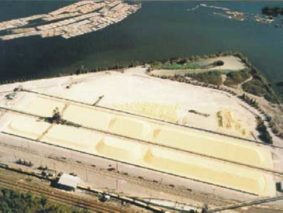
Stormwater Discharge Reduction at Pacific Coast Terminals

Project Highlights
Many industries around Burrard Inlet discharge their stormwater runoff to Greater Vancouver Regional District (GVRD) sewers. These discharges exacerbate occasional sanitary sewage and combined sewage overflows (SSOs and CSOs) to the inlet.
For this reason, the GVRD’s Liquid Waste Management Plan requires mitigation of such flows. The GVRD is working with local industries and the Vancouver Port Authority (VPA) to develop stormwater management plans that minimize the rates and volumes of stormwater inflows.
Objectives
The GVRD retained Kerr Wood Leidal (KWL) to develop a stormwater reduction plan for Pacific Coast Terminals Company Ltd. (PCT) in Port Moody. The objectives of this multi-phase project are to develop cost-effective short-term and long-term stormwater management plans that will reduce both the peak rate and volume of discharges to the GVRD sanitary sewage collection system, by means of flow diversion and/or storage.
PCT Site
PCT operates a bulk terminal for sulphur, ethylene glycol, and styrene monomer on Burrard Inlet in Port Moody. An effluent treatment plant (ETP) collects, treats, and discharges stormwater from the site to a GVRD sanitary sewer.
KWL’s Approach
KWL considered both technical and regulatory issues to develop comprehensive plans, including: PCT’s stormwater collection and treatment systems; PCT’s effects on the regional sewers; discharged water quality and quantities; VPA discharge criteria; and potential treatment requirements. This approach objectively considered the interests of the GVRD, the VPA, and PCT.
KWL then developed:
- a short-term plan than can be implemented readily for a reasonable cost
- an outline for a long-term plan, and
- a program of research required to finalize the long-term plan. The research program includes characterizing PCT’s effluent by compiling existing water quality data, effluent sampling, and performing comprehensive analyses for contaminants.
Recommendations
KWL recommended several low-cost strategies to immediately reduce stormwater discharges, including:
- Linking the PCT’s effluent pump controls to the liquid levels in GVRD’s sewers, so that pumping would be delayed when the latter approaches overflow, and
- Installing level-sensing equipment in the GVRD diversion facilities so that real-time monitoring and optimization could be performed. For the longer-term strategies, KWL recommended that uncontaminated discharges be diverted to the ocean. To conserve water and reduce effluent discharge, KWL also recommended recycling effluent for wash-down.
The initial phase of this project constitutes a pilot study that will benefit other industries in need of similar stormwater reduction plans. Applying this methodology to other areas of concern will ensure that the GVRD maintains a consistent and balanced approach to SSO/CSO reduction.






